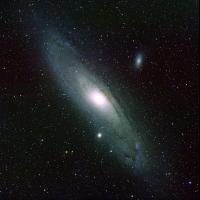
The Andromeda Galaxy
Copyright NOAO/AURA/NSF
At the turn of the 20th Century, a debate was raging in astronomy about faint, fuzzy objects called “nebulae.” Some astronomers thought nebulae were small clusters of stars in our own galaxy. Others saw some of them as giant, distant collections of stars, some larger than the Milky Way itself.
Finally, in 1924, American astronomer Edwin Hubble measured the distance to what was then called the Andromeda Nebula. He found it to lie over 2 million light-years from Earth. It was the first object to be recognized as another galaxy.
Hubble’s discovery changed our view of the universe. The already vast distances between stars were dwarfed by the incredible distances between galaxies. The universe was suddenly a much larger place than anyone had ever imagined.
The Sloan Digital Sky Survey has found more than 8 million galaxies so far. In this project, you will look at some of them to learn about different types of galaxies.
